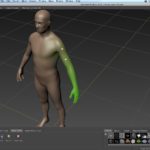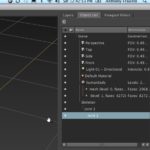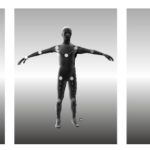Continued from page 2
Posing Improvements
Previously in Autodesk Mudbox 2011 you could not create weighted skeletons directly within the program, something we noted as a negative in our review. In this version that has been addressed.
Autodesk Mudbox 2012 introduces several improvements to posing your models. You can now create multiple joints so that model elements like arms for instance can be fully rigged, weighted and posed. (see image 05-07). There is a new smart-hierarchy logic that creates hierarchies based on influenced vertices. This can go amuck on you if you don’t take care when initially setting up your individual joints and weighting, which is the region of influence on a “vertice level.” Much practice will improve your ability at setting up complete skeletons in Mudbox 2012, however many professionals will most likely import in completely rigged models from other programs.
Another useful new feature is the ability to create pose presets. You execute this through saved poses which appear inside a new Go To Pose drop-down list. This can save you much time in future work and helps with such things as painting underarm areas and hard to reach places, because you can rapidly move model elements to expose those areas.
Sculpting and other Improvements
Autodesk has not added much in Mudbox 2012 in the way of sculpting. Improvements to Imprint Brush and Grab Brush are its only major updates in this arena. The Imprint brush now includes a Draw From Center option property, which lets you specify how the stamp image expands as you stroke.
Earlier we noted the two new Grab brush options for creating unique shapes.
There is also a new color hue window, enabling improved painting. There is a curves function also available. (see image 08).
The Viewport Filters have some minor changes too. The Ambient Occlusion filter has been renamed Cavity Ambient Occlusion filter. This filter shades the crevices of a model. A new Ambient Occlusion filter has been added. This is a more fully featured filter, which makes for a better final effect.
Finally, Autodesk Mudbox 2012 has new language support. The program is now available in French, German and Japanese.
Closing Comments
As we noted before Autodesk Mudbox’s primary competitor is Maxon’s BodyPaint 3D, and like BodyPaint works very well with the leading industry DCC 3D suites. Again we find Autodesk Mudbox 2012 a very attractive piece of software, largely because it has a very simplified and logical interface. We would love to see introductory learning videos that ship with the software updated and expanded more.
We noted last time that the program lacks complete UV editing tools. This issue still stands. Posing has improved but complex rigs are best left for other software. We think the company has done a good job in several areas and the performance abilities to load massive texture data sets is one of them. Overall, the improved 3D painting functionalities and integration with Adobe Photoshop, as well as the round-trip work with other Autodesk tools make this a strong upgrade. To learn more about Autodesk Mudbox 2012 visit them online here.
Pros: very intuitive and easy to learn 3D paint system; great help system; excellent new painting features and the new Ptex painting support for UV-less painting offers cutting edge innovation. Better posing tools–new weighted skeletons–and some nice new sculpting, color, and transparency support round out new features.
Cons: no true UV editing, as noted in earlier review; complex skeleton rigs are tricky if not truly limited with new tools.
Advice: Autodesk Mudbox 2012 is a solid contender for those venturing into 3D painting tools and a side-by-side option for those considering Maxon’s BodyPaint 3D.
Cost: 745.USD online direct. Other pricing options include bundles. Upgrade price is 375.USD. To learn more visit Autodesk’s Mudbox product page here. www.autodesk.com








Reader Comments
Comments for this story are closed